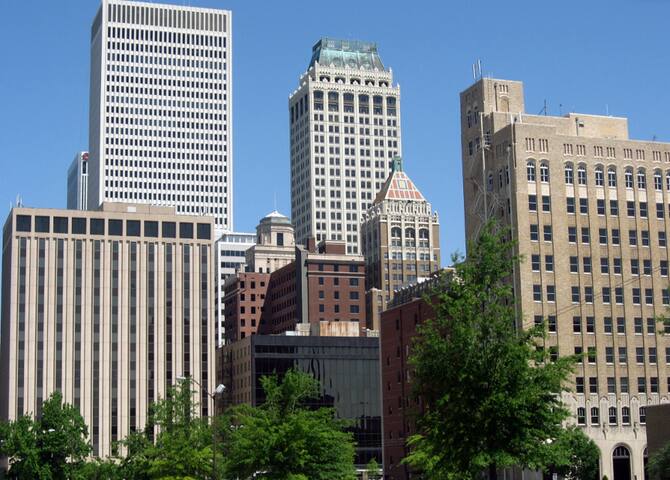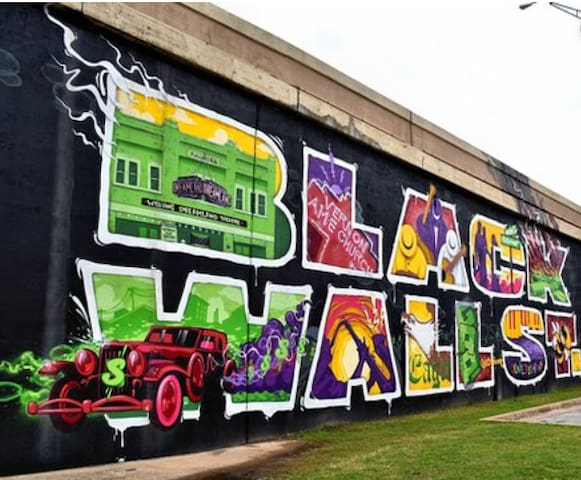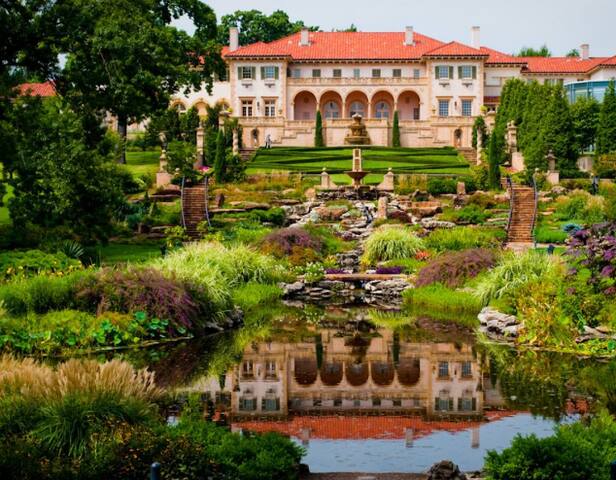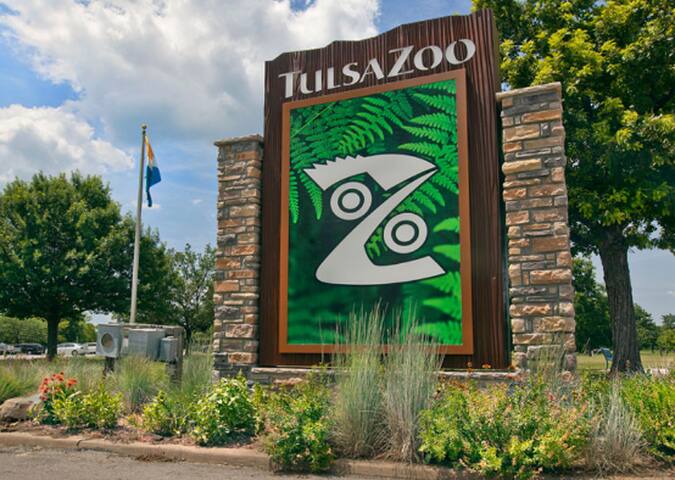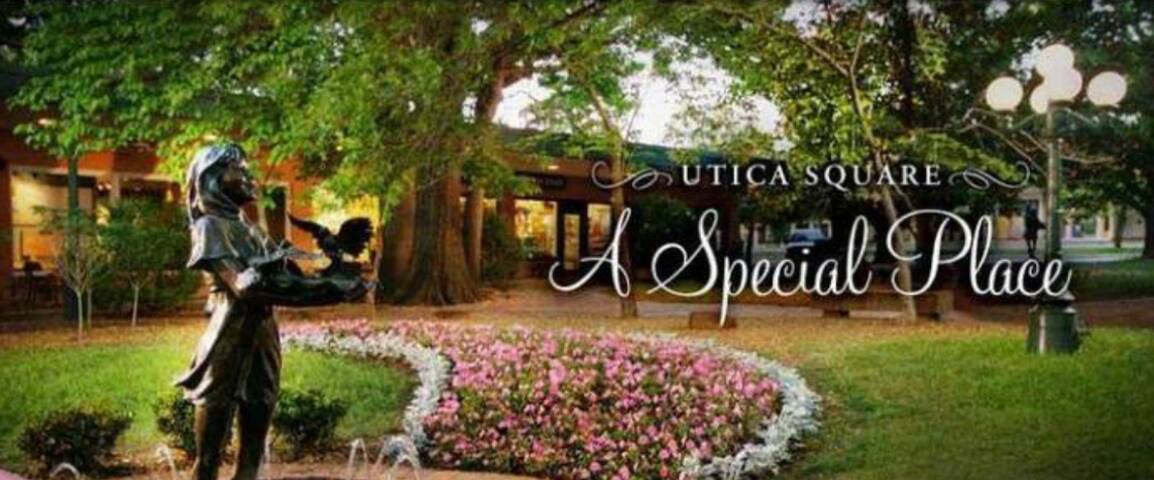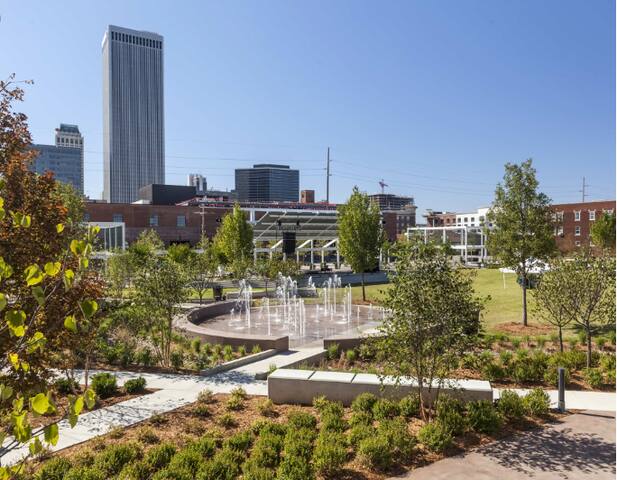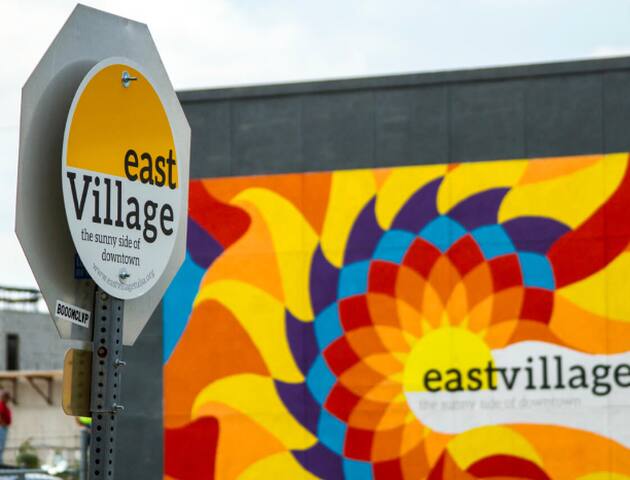Sightseeing
Tulsa’s Gathering Place was named the Best New Attraction in the nation in 2018 through the USA Today Readers’ Choice awards. In 2019, Gathering Place made Time Magazine's list of The World's 100 Greatest Places of 2019. The main attractions are the Chapman Adventure Playground, the Williams Lodge, a boathouse, splash playground, great lawn, outdoor sports courts, a skate park, a wetland pond and garden, and numerous trails among other locations. There are plenty of activities for kids and adults alike.
277 yerel halk öneriyor
Gathering Place
2650 South John Williams WayTulsa’s Gathering Place was named the Best New Attraction in the nation in 2018 through the USA Today Readers’ Choice awards. In 2019, Gathering Place made Time Magazine's list of The World's 100 Greatest Places of 2019. The main attractions are the Chapman Adventure Playground, the Williams Lodge, a boathouse, splash playground, great lawn, outdoor sports courts, a skate park, a wetland pond and garden, and numerous trails among other locations. There are plenty of activities for kids and adults alike.
Tulsa boasts one of the nation’s most extensive collections of Art Deco architecture, which is most visible in the downtown Deco District. This region spans the area from 1st to 8th street, with borders at Boston and Cheyenne. This area is located in the heart of the skyscrapers of Downtown Tulsa and thus has many food, beverage, and fitness options readily available. The Bartlett Square at 5th and Main provides a unique European feel to this region, but the entire area is overflowing with Tulsa charm.
10 yerel halk öneriyor
Deco District
Tulsa boasts one of the nation’s most extensive collections of Art Deco architecture, which is most visible in the downtown Deco District. This region spans the area from 1st to 8th street, with borders at Boston and Cheyenne. This area is located in the heart of the skyscrapers of Downtown Tulsa and thus has many food, beverage, and fitness options readily available. The Bartlett Square at 5th and Main provides a unique European feel to this region, but the entire area is overflowing with Tulsa charm.
Tulsa includes many structures built during the Oil Boom in the 1920s and 1930s, including Art Deco buildings such as the Mid-Continent Tower, Boston Avenue Methodist Church, and the Exchange Bank Building (today known as the 320 South Boston Building). Oilman Waite Phillips, left a significant architectural impact on downtown Tulsa through the Philtower and Philcade buildings. Other notable Tulsa buildings include the Atlas Life Building, Holy Family Cathedral, Holy Trinity Greek Orthodox Church, and the Mayo Hotel, the former of which once served as home to J. Paul Getty. Known for a time as "Terra Cotta City", Tulsa hosted the International Sixth Congress on Art Deco in 2001.
Downtown Tulsa is in the northwest quadrant of the city and is ringed by an expressway system called the inner dispersal loop. Downtown's buildings include many large office towers. At 667 ft (203 m), the BOK Tower (formerly One Williams Center) was the tallest building in any of the 5 "plains states" (Oklahoma, Kansas, Nebraska, North Dakota and South Dakota) until the Devon Tower in Oklahoma City was completed in 2012. The BOK Tower was designed in 1975 by Minoru Yamasaki & Associates, the same architect who designed the World Trade Center in New York City.
The Tulsa Performing Arts Center occupies a half city block in Tulsa's historical downtown. The PAC is also the design of Minoru Yamasaki. It houses five theatres and a reception hall. More than a quarter of a million people visit the Center each year to attend a performance from one of Tulsa's seven acclaimed musical and dramatic companies including the Tulsa Ballet, Tulsa Symphony Orchestra, Tulsa Opera, and a variety of symphonic groups. The PAC hosts a multitude of cultural events through the fall, winter and spring.
In 2005 the City of Tulsa broke ground on a 19,199 seat regional events center designed by architect César Pelli. The arena was named the BOK Center (or Bank of Oklahoma Center) and opened on August 30, 2008.
37 yerel halk öneriyor
Downtown
Tulsa includes many structures built during the Oil Boom in the 1920s and 1930s, including Art Deco buildings such as the Mid-Continent Tower, Boston Avenue Methodist Church, and the Exchange Bank Building (today known as the 320 South Boston Building). Oilman Waite Phillips, left a significant architectural impact on downtown Tulsa through the Philtower and Philcade buildings. Other notable Tulsa buildings include the Atlas Life Building, Holy Family Cathedral, Holy Trinity Greek Orthodox Church, and the Mayo Hotel, the former of which once served as home to J. Paul Getty. Known for a time as "Terra Cotta City", Tulsa hosted the International Sixth Congress on Art Deco in 2001.
Downtown Tulsa is in the northwest quadrant of the city and is ringed by an expressway system called the inner dispersal loop. Downtown's buildings include many large office towers. At 667 ft (203 m), the BOK Tower (formerly One Williams Center) was the tallest building in any of the 5 "plains states" (Oklahoma, Kansas, Nebraska, North Dakota and South Dakota) until the Devon Tower in Oklahoma City was completed in 2012. The BOK Tower was designed in 1975 by Minoru Yamasaki & Associates, the same architect who designed the World Trade Center in New York City.
The Tulsa Performing Arts Center occupies a half city block in Tulsa's historical downtown. The PAC is also the design of Minoru Yamasaki. It houses five theatres and a reception hall. More than a quarter of a million people visit the Center each year to attend a performance from one of Tulsa's seven acclaimed musical and dramatic companies including the Tulsa Ballet, Tulsa Symphony Orchestra, Tulsa Opera, and a variety of symphonic groups. The PAC hosts a multitude of cultural events through the fall, winter and spring.
In 2005 the City of Tulsa broke ground on a 19,199 seat regional events center designed by architect César Pelli. The arena was named the BOK Center (or Bank of Oklahoma Center) and opened on August 30, 2008.
The Greenwood Historical District is just north of downtown and east of the Brady District. It was once one of the most affluent African-American communities in the United States and referred to as Black Wall Street. In 1921, thirty-five blocks of businesses and residences were burned in this district during the infamous Tulsa Race Riot, the bloodiest racial riot in the history of the United States. The Oklahoma Legislature passed laws in 2001 aimed at revitalizing Greenwood, setting up a scholarship fund for college-bound descendants of riot victims and appropriating $2 million for a riot memorial. As of 2004, two blocks of the old neighborhood have been restored and are part of the Greenwood Historical District. It is now home to the Greenwood Cultural Center, the Tulsa Race Riot Memorial, and the Oklahoma Jazz Hall of Fame, as well as Oklahoma State University - Tulsa and Langston University-Tulsa.
Because of its rich history, the Greenwood Historical District provides visitors with one of the most unique cultural experiences in Tulsa. The John Hope Franklin Reconciliation Park details the relationship between African-Americans and the state of Oklahoma throughout history with an emphasis on the Tulsa Race Riot. The Mabel B Little Heritage House takes visitors back to the 1920s with its classic furnishings and information about the Riots. The Greenwood Cultural Center strives to educate on the unique history of the Greenwood District, with a focus on jazz and the blues as well. Alongside these important landmarks in the Greenwood District lies a growing retail district bordering OneOK Field on the east.
28 yerel halk öneriyor
Greenwood District
The Greenwood Historical District is just north of downtown and east of the Brady District. It was once one of the most affluent African-American communities in the United States and referred to as Black Wall Street. In 1921, thirty-five blocks of businesses and residences were burned in this district during the infamous Tulsa Race Riot, the bloodiest racial riot in the history of the United States. The Oklahoma Legislature passed laws in 2001 aimed at revitalizing Greenwood, setting up a scholarship fund for college-bound descendants of riot victims and appropriating $2 million for a riot memorial. As of 2004, two blocks of the old neighborhood have been restored and are part of the Greenwood Historical District. It is now home to the Greenwood Cultural Center, the Tulsa Race Riot Memorial, and the Oklahoma Jazz Hall of Fame, as well as Oklahoma State University - Tulsa and Langston University-Tulsa.
Because of its rich history, the Greenwood Historical District provides visitors with one of the most unique cultural experiences in Tulsa. The John Hope Franklin Reconciliation Park details the relationship between African-Americans and the state of Oklahoma throughout history with an emphasis on the Tulsa Race Riot. The Mabel B Little Heritage House takes visitors back to the 1920s with its classic furnishings and information about the Riots. The Greenwood Cultural Center strives to educate on the unique history of the Greenwood District, with a focus on jazz and the blues as well. Alongside these important landmarks in the Greenwood District lies a growing retail district bordering OneOK Field on the east.
Tulsa Botanic Garden is developing on 170 acres just northwest of downtown Tulsa. Explore the A.R. and Marylouise Tandy Floral Terraces, an ornamental garden featuring over 8,000 trees, shrubs, and perennials as well as one of the largest spring bulb displays in the state. The Children's Discovery Garden offers hands-on fun for all ages with carnivorous plants, a tree fort, insect whirligigs and the one-of-a-kind Spring Giant. Nature lovers and birders will enjoy hiking a trail through both tallgrass prairie and Cross Timbers forest.
47 yerel halk öneriyor
Tulsa Botanik Bahçesi
3900 Tulsa Botanic DrTulsa Botanic Garden is developing on 170 acres just northwest of downtown Tulsa. Explore the A.R. and Marylouise Tandy Floral Terraces, an ornamental garden featuring over 8,000 trees, shrubs, and perennials as well as one of the largest spring bulb displays in the state. The Children's Discovery Garden offers hands-on fun for all ages with carnivorous plants, a tree fort, insect whirligigs and the one-of-a-kind Spring Giant. Nature lovers and birders will enjoy hiking a trail through both tallgrass prairie and Cross Timbers forest.
Guthrie Green is an urban garden and performance space in the Tulsa Arts District of downtown Tulsa. Accommodating visitors looking for a peaceful escape or family activities, the park features a stage, The Dock pavilion, tree-lined paths, shade structures, water features and a large lawn. In addition to the markets, festivals and concerts planned for Guthrie Green, park visitors can enjoy a simple walk or lunch at the park to experience an urban green space unlike any other in Tulsa. Enjoy regular concerts, movies, fitness classes, food trucks, and much more at Guthrie Green. All events are free and open to the public!
94 yerel halk öneriyor
Guthrie Green Parkı
111 E Reconciliation WayGuthrie Green is an urban garden and performance space in the Tulsa Arts District of downtown Tulsa. Accommodating visitors looking for a peaceful escape or family activities, the park features a stage, The Dock pavilion, tree-lined paths, shade structures, water features and a large lawn. In addition to the markets, festivals and concerts planned for Guthrie Green, park visitors can enjoy a simple walk or lunch at the park to experience an urban green space unlike any other in Tulsa. Enjoy regular concerts, movies, fitness classes, food trucks, and much more at Guthrie Green. All events are free and open to the public!
The Expo Square Pavilion, sometimes called simply The Pavilion, and formerly known as the Tulsa Fairgrounds Pavilion, is a 6,311-seat multi-purpose arena, in the Tulsa State Fairgrounds in Tulsa, Oklahoma. It was built in 1932; the architect was Leland I Shumway. The building is in the PWA Art Deco style, built of blond brick with terra cotta ornamentation, and is considered one of the prime examples of Art Deco architecture in Tulsa.
10 yerel halk öneriyor
Tulsa Eyalet Fuarı
4145 E 21st StThe Expo Square Pavilion, sometimes called simply The Pavilion, and formerly known as the Tulsa Fairgrounds Pavilion, is a 6,311-seat multi-purpose arena, in the Tulsa State Fairgrounds in Tulsa, Oklahoma. It was built in 1932; the architect was Leland I Shumway. The building is in the PWA Art Deco style, built of blond brick with terra cotta ornamentation, and is considered one of the prime examples of Art Deco architecture in Tulsa.
The Philbrook Museum of Art is an art museum in the historic home of Waite and Genevieve Phillips with expansive formal gardens located in Tulsa, Oklahoma featuring two locations. The main site is located in part in a former 1920s villa, and a satellite facility known as Philbrook Downtown, is found in Tulsa's Brady Arts District. Showcasing nine collections of art from all over the world, and spanning various artistic media and styles, the cornerstone collection focuses on Native American art featuring basketry, pottery, paintings and jewelry.
237 yerel halk öneriyor
Philbrook Sanat Müzesi
2727 S Rockford RdThe Philbrook Museum of Art is an art museum in the historic home of Waite and Genevieve Phillips with expansive formal gardens located in Tulsa, Oklahoma featuring two locations. The main site is located in part in a former 1920s villa, and a satellite facility known as Philbrook Downtown, is found in Tulsa's Brady Arts District. Showcasing nine collections of art from all over the world, and spanning various artistic media and styles, the cornerstone collection focuses on Native American art featuring basketry, pottery, paintings and jewelry.
The Tulsa Zoo is a 85-acre non-profit zoo located in Tulsa, Oklahoma, United States. The Tulsa Zoo is owned by the City of Tulsa, but since 2010 has been privately managed by Tulsa Zoo Management, Inc. The zoo is located in Mohawk Park, one of the largest municipal parks in the United States. The zoo is involved in many conservation efforts, such as a push to reduce the use of palm oil, FrogWatch USA, and efforts to encourage ocean conservation.
105 yerel halk öneriyor
Tulsa Hayvanat Bahçesi
6421 E 36th St NThe Tulsa Zoo is a 85-acre non-profit zoo located in Tulsa, Oklahoma, United States. The Tulsa Zoo is owned by the City of Tulsa, but since 2010 has been privately managed by Tulsa Zoo Management, Inc. The zoo is located in Mohawk Park, one of the largest municipal parks in the United States. The zoo is involved in many conservation efforts, such as a push to reduce the use of palm oil, FrogWatch USA, and efforts to encourage ocean conservation.
Food scene
Whether it's sampling one of over 20 restaurants in the area or viewing Tulsa's finest local and regional art galleries, Cherry Street offers entertainment for everyone. A hot spot for decades, Cherry Street features the highest number of locally owned businesses in town. The Cherry Street District is set near downtown in the northern midtown area. Visitors to this neighborhood find great shopping, particularly antiques and collectibles, a variety of local eateries, as well as some fabulous old homes in the surrounding residential areas.
100 yerel halk öneriyor
Cherry Street
Whether it's sampling one of over 20 restaurants in the area or viewing Tulsa's finest local and regional art galleries, Cherry Street offers entertainment for everyone. A hot spot for decades, Cherry Street features the highest number of locally owned businesses in town. The Cherry Street District is set near downtown in the northern midtown area. Visitors to this neighborhood find great shopping, particularly antiques and collectibles, a variety of local eateries, as well as some fabulous old homes in the surrounding residential areas.
Utica Square is an upscale tree-lined outdoor shopping center open since 1952 in the heart of midtown Tulsa. The shopping center features a number of smaller, mostly independent shops, casual dining and upscale chain brand stores.
141 yerel halk öneriyor
Utica Square
1709 Utica SquareUtica Square is an upscale tree-lined outdoor shopping center open since 1952 in the heart of midtown Tulsa. The shopping center features a number of smaller, mostly independent shops, casual dining and upscale chain brand stores.
Formerly known as the Brady Arts District, the Tulsa Art District is located north across the Sante Fe Railroad tracks from the central business district and centered at Main Street & Brady Avenue. The Brady District is one of Tulsa's oldest areas, characterized by two-story brick warehouses. The Brady Theater, built between 1912 and 1914, was originally designed to serve as the city's municipal auditorium and was simply called "Convention Hall" for the first forty years of its life and was one of three internment camps where African Americans were detained after the 1921 Tulsa Race Riot. In 1952, major additions were added and the building was renamed Tulsa Municipal Theater. The building was listed on the National Register of Historic Places in 1979. Supplanted as the city auditorium in 1979 by construction of the Performing Arts Center in downtown, "the Old Lady on Brady" continues to be used today for a wide variety of concerts and theatrical productions.
45 yerel halk öneriyor
Brady Arts District
Formerly known as the Brady Arts District, the Tulsa Art District is located north across the Sante Fe Railroad tracks from the central business district and centered at Main Street & Brady Avenue. The Brady District is one of Tulsa's oldest areas, characterized by two-story brick warehouses. The Brady Theater, built between 1912 and 1914, was originally designed to serve as the city's municipal auditorium and was simply called "Convention Hall" for the first forty years of its life and was one of three internment camps where African Americans were detained after the 1921 Tulsa Race Riot. In 1952, major additions were added and the building was renamed Tulsa Municipal Theater. The building was listed on the National Register of Historic Places in 1979. Supplanted as the city auditorium in 1979 by construction of the Performing Arts Center in downtown, "the Old Lady on Brady" continues to be used today for a wide variety of concerts and theatrical productions.
East Village comprises 115 acres bordered by East 2nd and East 7th Streets, Detroit Avenue and Lansing Avenue, just inside the inner-dispersal loop. This area boasts an upscale martini bar, a hair salon, a pet day care, photography studios, lofts, a knitting room and living arts district, among others. The cornerstone of this neighborhood is the fifth largest LGBT community center in the United States, the Dennis R. Neill Equality Center, owned and operated by Oklahomans for Equality/OkEq (formerly Tulsa Oklahomans for Human Rights/TOHR), with further development being planned for more restaurants, residential lofts and retail.
The development in the East Village has provided Tulsans and visitors with many food and entertainment opportunities. With areas like the Bond Center for large events intertwined with luxurious apartment complexes, the feeling of community is particularly strong within this area. The Boxyard- a shopping complex made from repurposed shipping containers- has quickly become a popular destination for local shopping and eating within the East Village. The annual MOJO music fest occurs in this region, mixing live music with local craft beers and food trucks. Regardless of interest, the East Village District has something for everyone in Downtown Tulsa.
7 yerel halk öneriyor
East Village District
East Village comprises 115 acres bordered by East 2nd and East 7th Streets, Detroit Avenue and Lansing Avenue, just inside the inner-dispersal loop. This area boasts an upscale martini bar, a hair salon, a pet day care, photography studios, lofts, a knitting room and living arts district, among others. The cornerstone of this neighborhood is the fifth largest LGBT community center in the United States, the Dennis R. Neill Equality Center, owned and operated by Oklahomans for Equality/OkEq (formerly Tulsa Oklahomans for Human Rights/TOHR), with further development being planned for more restaurants, residential lofts and retail.
The development in the East Village has provided Tulsans and visitors with many food and entertainment opportunities. With areas like the Bond Center for large events intertwined with luxurious apartment complexes, the feeling of community is particularly strong within this area. The Boxyard- a shopping complex made from repurposed shipping containers- has quickly become a popular destination for local shopping and eating within the East Village. The annual MOJO music fest occurs in this region, mixing live music with local craft beers and food trucks. Regardless of interest, the East Village District has something for everyone in Downtown Tulsa.
The Blue Dome District is known for its local dining options, large art festival, and scenic Downtown Tulsa views. Every May, the Blue Dome Arts Festival allows families to enjoy local music and street vendors surrounding the historic dome. Further, there is no bad angle for pictures of Tulsa's infamous skyline in this district. With so many delicious restaurants and walkable views, it is no wonder that the Blue Dome District continues to bring its unique art scene to Tulsa.
41 yerel halk öneriyor
Blue Dome District
The Blue Dome District is known for its local dining options, large art festival, and scenic Downtown Tulsa views. Every May, the Blue Dome Arts Festival allows families to enjoy local music and street vendors surrounding the historic dome. Further, there is no bad angle for pictures of Tulsa's infamous skyline in this district. With so many delicious restaurants and walkable views, it is no wonder that the Blue Dome District continues to bring its unique art scene to Tulsa.
For nearly 20 years, the Pearl District Association has united residents, business owners, and city government behind a series of plans that have turned this once neglected expanse east of downtown into an "overnight" success. The Pearl is up-and-coming by design — made with the people wanting to make their lives and livelihoods here.
23 yerel halk öneriyor
The Pearl
For nearly 20 years, the Pearl District Association has united residents, business owners, and city government behind a series of plans that have turned this once neglected expanse east of downtown into an "overnight" success. The Pearl is up-and-coming by design — made with the people wanting to make their lives and livelihoods here.
Filled with quaint boutiques, art galleries, antique shops and trendy restaurants, Brookside turns into a neon avenue at night, with clubs and bars bringing out crowds for nightlife.
35 yerel halk öneriyor
Brookside By Day
3313 S Peoria AveFilled with quaint boutiques, art galleries, antique shops and trendy restaurants, Brookside turns into a neon avenue at night, with clubs and bars bringing out crowds for nightlife.



